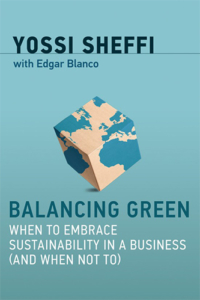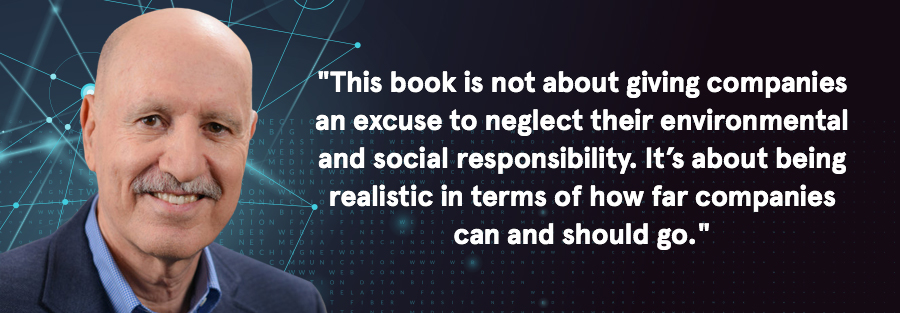Yossi Sheffi, Professor, Author and Director of the MIT Center for Transportation and Logistics
SCN: In your new book, Balancing Green: When to Embrace Sustainability in Business (and When Not To), you propose that it is not only reasonable, but often advisable, for some companies to minimize their investments in sustainability. What lead you to this somewhat controversial conclusion?
YS: Well, the basis for this book was research I conducted to find out how businesses of all sizes are addressing environmental sustainability (greenhouse gases, energy, water, toxins, waste and recycling). I didn’t go into this project looking to prove or disprove any theory, I really just wanted to have a better idea of what was really happening. My team interviewed hundreds of executives about their companies’ sustainability strategies and what we found was that many companies are making a big deal about sustainability in their PR and speeches etc., but they are really just going through the motions – replacing light bulbs, putting in bike stands – incremental small stuff that doesn’t really move the needle. But, they are absolutely right for doing it this way.
Why? Because companies exist to serve their customers and despite all the surveys in which consumers report they are willing to pay more for green products, there is still a significant misalignment between what consumer say and what they actually do. We call this the “say-pay” gap.
“Companies exist to serve their customers and despite all the surveys in which consumers report they are willing to pay more for green products, there is still a significant misalignment between what consumer say and what they actually do… If consumers don’t support corporate sustainability with loyalty and preference, then it’s a suicide mission.”
We see this everyday, for example, when an Amazon.com customer happily accepts next day or same day shipping options, even when the reality is they don’t need that product immediately. They like the convenience and dismiss the packaging waste and the ozone-depleting emissions and fossil fuel consumption that result from the less efficient, one-off shipping policy.
If consumers don’t support corporate sustainability with loyalty and preference, then it’s a suicide mission. These companies will become increasingly less profitable, to the point that they lose investors and market cap and next thing you know they are either being shuttered or absorbed by a competitor. This is a progression that most organizations today can logically expect.
SCN: So, are you proposing that companies delay any substantial sustainability initiatives until consumer behavior catches up with the public narrative?
 YS: This book is not about giving companies an excuse to neglect their environmental and social responsibility. It’s about being realistic in terms of how far companies can and should go in a world in which Western consumers say they want sustainability but, by and large are not willing to pay for it or be inconvenienced, and where sustainability is a luxury good for most developing companies’ consumers.
YS: This book is not about giving companies an excuse to neglect their environmental and social responsibility. It’s about being realistic in terms of how far companies can and should go in a world in which Western consumers say they want sustainability but, by and large are not willing to pay for it or be inconvenienced, and where sustainability is a luxury good for most developing companies’ consumers.
The book tries to offer a pragmatic picture of the conflicting constraints and demands of customers, competitors, employees, neighbors, investors, activists, local governments and regulators. It’s not about placing blame, and deciding who is right and who is wrong, but providing examples of how companies have addressed the many competing priorities in ways that balance environmental sustainability with jobs and the provision of affordable products.
SCN: Based on your research and experience, when it does make sense for companies to integrate environmental sustainability into their core business strategy?
YS: The short answer is that the degree that companies can implement beneficial strategies without handicapping their profitability, then by all means, they should. For example, BMW has successfully developed a process by which they can power their Spartanburg, NC plant with methane from a landfill. At the end of the day, this represents just a small part of the automaker’s energy consumption, so in terms of what Al Gore says is the “challenge of our time,” there is not that much impact, but there is no reason not to do it.
The longer answer is that there are three main business rationales for corporate sustainability efforts that generally align with the economic goals of the company. A full description of these opportunities is in my book, but here is the gist.
Eco-risk: Companies need to consider the segment of consumers and social justice warriors that ardently believe corporations have a moral duty to minimize their impact and, whenever possible, do their part to reverse existing damage. Companies that do not show at least a modicum of attention to these groups could find themselves facing a product boycott or nasty brand-damaging social media campaign.
Eco-hedging: These initiatives entail offering new green products to market segments willing to pay for them. They may be justified either as growth opportunities or as a form of hedging to ensure the company is not blindsided by future demand shifts or new regulations. Companies may even lose money on such offering but they get to know the suppliers, the processes, the materials and the customers of such products, “just in case.”
Eco-efficiency (cost savings): There are many legitimate ways in which investments in green initiatives can yield cost savings, particularly within supply chain operations. For example, more efficient use of freight transportation capacity can shrink a company’s carbon footprint and capture cost savings. Retailer Macy’s joined a program that posts retailers’ empty miles and finds shippers that can take advantage of the unused truck capacity. As a result, they eliminated 21 percent of empty miles and saved about $1.75 million annually.
SCN: In your recent debate with sustainability expert Andrew Winston, you suggested that the only “effective response” to the climate change situation is through the deployment of as-yet-undeveloped technology. Please explain your theory.
YS: While the latest IPCC and US Government report make it clear that the situation regarding climate change is bad and getting worse, that doesn’t mean that climate change is a lost cause or mischievous myth-making. To avoid the most extreme impacts of global warming and to possibly reverse the trend, the rich nations of the world need to band together and fund not billions but trillions of dollars-worth of research in a global “Manhattan Project” or “Moon Shot” initiative.
A climate change-focused Manhattan Project would deploy peacetime technologies to counter the threat of climate-induced mass dislocation. These could include technologies such as carbon sequestration and geo-engineering, as well as innovations such as plant-based meat and alternatives to concrete. It would also include a combination of existing technologies such as wind, sun, and nuclear power. Moreover, a concerted effort to marshal the planet’s technological resources would undoubtedly lead to the development of new innovations and approaches. We do have time to deploy the planet’s technological riches to reverse the build-up of damaging GHGs. We just need the will.
“When companies design for sustainability, it’s not just materials and manufacturing processes that may be impacted, but the use phase, which consists of all the consumer’s activities and processes associated with the use of a product or service.”
SCN: What are some of the less commonly discussed opportunities to influence sustainability throughout the cradle-to-grave product life cycle?
YS: There are a large number of possible avenues for improving sustainability across the subset of domains in an organization: manufacturing, procurement, distribution, transportation, design, marketing and upper management.
Take design for example. When companies “design for sustainability,” it’s not just materials and manufacturing processes that may be impacted, but the “use phase,” which consists of all the consumer’s activities and processes associated with the use of a product or service. Companies have the most ability to influence factors that will determine how well a product can minimize the power, fuel and water consumption in the design stage.
As Hannah Jones, vice president of sustainable business and innovation at Nike stated: “Designers are at the start of everything, and if we can educate the designer to make better choices, then they can become agents of change for the entire industry.”
In the book, I present a case study of Dyson’s experience in conducting a life cycle assessment for the use-phase footprint of its Airblade unit. The long, arduous process began with mundane tasks such as defining what constitutes fundamental factors like “use” and “dry,” but in the end, it was determined that the Airblade’s innovative design was able to reduce the total energy expended with each use by five times the consumption of traditional electric dryers, on the average.
“It is easy to vilify companies and their leadership as cold-hearted capitalists, but when you walk a mile in the shoes of today’s corporate executives, you get a very different picture. These men and women are not just weighing the trade-offs of people vs. profit. They are making decisions that are impacting jobs that enable people to feed their families.”
SCN: Any final thoughts?
YS: Yes, one thing I would like readers to take away from this book is that it is easy to vilify companies and their leadership as cold-hearted capitalists, but when you walk a mile in the shoes of today’s corporate executives, you get a very different picture. These men and women are not just weighing the trade-offs of people vs. profit. They are making decisions that are impacting jobs that enable people to feed their families. They are responsible for making affordable goods available to individuals in a range of socio-economic conditions. And they can do some things that make sense, as mentioned above, but until their customers will demand change and will be willing to pay for it, companies cannot be expected to make the fundamental changes that are required in order to reverse global warming, save the oceans, or work in a real circular economy.
